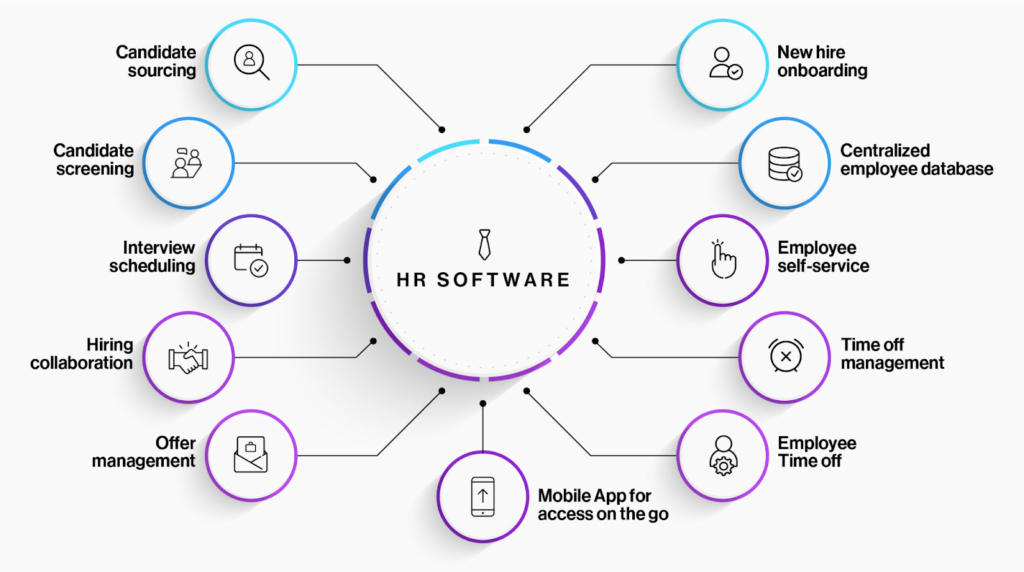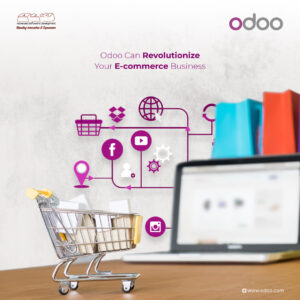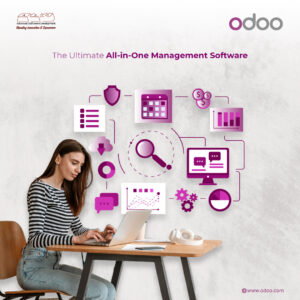In today’s fast-paced business landscape, the role of HR professionals has become more critical than ever. The COVID-19 pandemic has brought about unprecedented disruptions, making effective people management a top priority for organizations worldwide. And at the heart of efficient HR operations lies the right HR software.
Gone are the days of manual paperwork and tedious administrative tasks. Right HR software has emerged as a game-changer, streamlining HR processes, enhancing employee experiences, and empowering HR professionals to focus on strategic initiatives.
However, with the market flooded with a plethora of HR tools, choosing the right software can feel like navigating a maze. So, we created a comprehensive guide that you can follow to find the perfect match for you! But first, let’s give a quick run down on HR software.
What is HR Software?
HR software, short for Human Resources software, is a digital solution designed to streamline and automate various HR processes. HR software covers multiple functions, from recruitment and onboarding to payroll management and employee performance tracking.
It is a centralized hub where HR professionals can easily store, organize, and access crucial employee data.
Types of HR Software
HR software comes in different flavors, catering to the diverse needs of human resource professionals. The most common types include:
- HRIS (Human Resources Information System): This software focuses on core HR functions, such as employee data management, time and attendance tracking, and benefits administration.
- HCM (Human Capital Management): HCM software takes HRIS to the next level by integrating additional features like talent management, workforce planning, and performance management. It provides a holistic view of an organization’s human capital and enables strategic workforce planning.
- HRMS (Human Resources Management System): HRMS software combines HRIS and HCM functionalities, offering a comprehensive suite of tools to manage all aspects of HR operations. It encompasses everything from recruitment and onboarding to training, development, and employee engagement.
Benefits of Implementing HR Software
Now that we know what HR software is let’s discuss the exciting part: the benefits they bring to HR professionals like yourself. Here are a few key advantages of implementing HR software in your organization:
Streamlined Processes
Right HR software automates time-consuming administrative tasks, allowing HR professionals to focus on strategic initiatives. It eliminates manual paperwork, reduces errors, and ensures data accuracy and compliance.
Enhanced Efficiency
HR software enables seamless collaboration and communication within the team by centralizing employee data and processes. It speeds up information retrieval, simplifies reporting, and improves operational efficiency.
Data-Driven Insights
HR software provides professionals access to real-time data and analytics, empowering data-driven decision-making. It helps you identify trends, analyze workforce metrics, and optimize resource allocation for better financial outcomes.
Improved Employee Experience
HR software streamlines employee self-service portals, making it easier for employees to access and update their information. It fosters a positive employee experience by enabling self-service for tasks like leave requests, benefits enrollment, and performance feedback.
A Comprehensive Guide on Choosing the right HR Software
We have already discussed why you want integrated HR software for your company. However, too many software options are available to choose one right away.
So, we will give you a checklist that you can follow to always find the right HR software that fits your office’s morals and regulations.
Define Your Requirements
When choosing the right HR software for your team, clearly defining your requirements is crucial.
To help you navigate through the sea of options, let’s explore some essential features and functionalities to consider. These features will empower your workforce to streamline operations, enhance employee experiences, and drive financial success.
Personnel Tracking
A robust HR software should provide comprehensive personnel tracking capabilities.
This includes storing and managing employee information, such as personal details, employment history, certifications, and performance records. Look for features that allow easy access, updates, and secure storage of employee data.
Example: HR software solutions like Workday and BambooHR offer robust personnel tracking features.
Employee Benefits Administration
Managing employee benefits can be a complex task. Look for HR software that simplifies benefits administration by automating enrollment, tracking, and reporting processes.
Features like benefits selection, eligibility management, and integration with insurance providers can significantly streamline your benefits management workflow.
Example: Platforms like Zenefits and Gusto specialize in benefits administration. They automate benefits enrollment, eligibility management, and integration with insurance providers.
Reporting
You must access accurate and insightful data to make informed decisions. Ensure the HR software you choose offers robust reporting capabilities.
Look for features that allow you to generate customized reports on key HR metrics, such as turnover rates, training effectiveness, and workforce demographics.
The ability to export data in various formats, such as spreadsheets or visual dashboards, can further enhance your reporting capabilities.
Example: HR software systems like ADP and Paychex provide powerful reporting capabilities. They allow you to generate custom reports on various HR metrics, visualize data through intuitive dashboards, and export reports in formats that suit your financial analysis needs.
Onboarding
Efficient onboarding processes are essential for smooth employee transitions and productivity.
Look for HR software that offers onboarding features like document management, task tracking, and automated workflows. These features enable you to create structured onboarding programs, track progress, and ensure a positive employee experience from day one.
Example: HR software solutions such as BambooHR and Namely offer comprehensive onboarding features.
They provide document management, task tracking, and automated workflows to ensure a seamless onboarding experience for new hires and smooth transitions for the company.
Performance Management
Managing employee performance is critical for driving financial success.
Look for best HR software that provides performance management features like goal setting, performance reviews, and feedback mechanisms.
Tracking and analyzing employee performance data can help you identify top performers, address skill gaps, and align individual goals with organizational objectives.
Example: Performance management solutions like Performance Pro and 15 Five focus on optimizing employee performance.
They enable goal setting, performance reviews, and real-time feedback, allowing you to align individual performance with business objectives and drive financial success.
Vendor Evaluation
You should clearly understand the essential features and functionalities you need in your HR software. Now, it’s time to evaluate the vendors who offer these solutions.
Assessing potential vendors’ reputation, reliability, and customer support is crucial to ensure a successful partnership. Additionally, vendor stability, security, and data protection are vital to safeguard your company’s sensitive information.
Reputation
Research the vendor’s reputation in the industry. Look for customer reviews, testimonials, and case studies to gain insights into their track record. A vendor with a positive reputation is more likely to provide reliable and high-quality software solutions.
Reliability
Evaluate the vendor’s reliability by assessing factors such as system uptime, performance, and the frequency of software updates. Ensure that the vendor has a history of delivering stable and dependable software solutions that meet the needs of their customers.
Customer Support
Excellent customer support is essential for a smooth implementation and ongoing usage of the right HR software. Assess the vendor’s customer support offerings, such as availability, response times, and the availability of dedicated support representatives.
Look for vendors with a reputation for prioritizing customer satisfaction and timely assistance.
Vendor Stability:
Evaluate the vendor’s financial stability and longevity in the market. A stable vendor will likely continue providing updates, enhancements, and support for their software solutions in the long run.
Assess their track record and stability indicators to ensure a reliable partnership.
Security Measures:
Data security is paramount when it comes to HR software. Inquire about the vendor’s security measures, such as data encryption, access controls, and regular security audits.
Ensure they comply with industry standards and regulations to protect your team’s sensitive information.
Data Protection:
Assess the vendor’s data protection practices, including data backup, disaster recovery plans, and data ownership policies. Clarify how they handle your data, where it is stored, and their policies regarding data privacy and confidentiality.
Choose a vendor who prioritizes data protection and aligns with your organization’s data governance requirements.
Pricing:
Last but not least, consider the pricing structure and licensing options the vendors offer. Evaluate whether the pricing aligns with your budget and the value you expect from the software.
You also need to make an ROI assessment. Let’s discuss pricing and ROI in a separate section below for a clear understanding.
Pricing and ROI Assessment
Now comes the part where we evaluate the pricing models offered by different HR software vendors and calculate your organization’s potential return on investment (ROI).
This step is crucial in making a well-informed decision that aligns with your budget and maximizes the value you’ll receive from the HR software.
Regarding pricing, Right HR software vendors typically offer various models to cater to different business needs. Here are a few standard pricing models to consider:
- Subscription-Based: Many vendors offer a subscription-based model where you pay a monthly or annual fee to access their software. This model often includes regular updates and customer support.
- Per-User Pricing: Some vendors charge based on the software’s number of users. This can be beneficial if you have a small team or your team size fluctuates throughout the year.
- Tiered Pricing: Vendors may offer tiered pricing plans with different levels of features and support. This allows you to choose a plan that aligns with your organization’s requirements and budget.
Another necessary calculation is your potential return on investment (ROI). To calculate the ROI, consider the following;
- Cost Savings: Look at the areas where the right HR software can help save costs. For example, it can automate manual tasks, reduce paperwork, and minimize errors. Calculate the potential savings regarding time, resources, and efficiency improvements.
- Productivity Improvements: HR software can streamline processes, enhance collaboration, and provide insights that enable better decision-making. Assess how these improvements can positively impact your team’s productivity and overall business performance.
To calculate ROI, compare the estimated cost of implementing and maintaining the HR software with the projected cost savings and productivity improvements. Remember to consider short-term and long-term benefits to get a comprehensive view of the potential ROI.
Conclusion
Congratulations! You’ve reached the end of our comprehensive guide on choosing the right HR software for your organisation. Consider essential features like personnel tracking, benefits administration, reporting, onboarding, and performance management.
Evaluate vendors based on reputation, reliability, customer support, stability, security, and data protection. Assess pricing models and calculate potential ROI to make an informed decision.
The right HR software streamlines processes improves efficiency, and enhances employee experiences. Take your time, conduct thorough research, and choose wisely. Best of luck on your HR software journey!



